Cost Accounting Assignment: Financial vs. Cost Accounting Analysis
VerifiedAdded on 2023/01/16
|20
|4949
|1
Homework Assignment
AI Summary
This assignment delves into the core principles of cost accounting, beginning with a detailed definition of cost accounting, its objectives, and various classifications. It explores the critical differences between financial and cost accounting, highlighting their distinct purposes and applications. The assignment also examines the concept of cost drivers and their role in overhead application rates. A significant portion is dedicated to preparing a cost sheet for AJ Corporation Ltd, utilizing provided financial data to calculate key cost components. Furthermore, the assignment includes variance analysis, breakeven point calculations, and in-depth interpretations of the financial data. The solution addresses all the questions in the assignment brief, providing a comprehensive understanding of cost accounting principles and their practical applications in a business context.
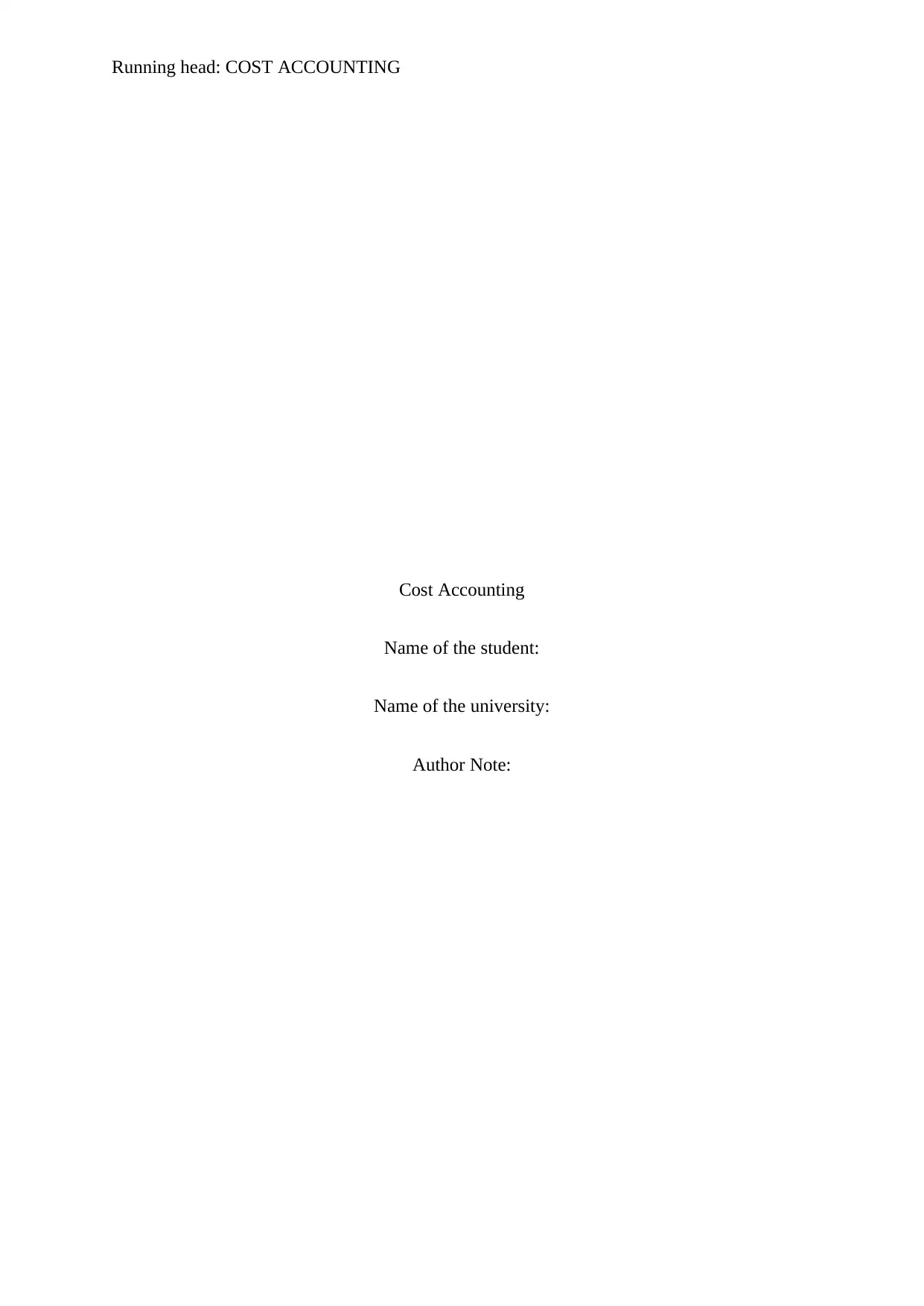
Running head: COST ACCOUNTING
Cost Accounting
Name of the student:
Name of the university:
Author Note:
Cost Accounting
Name of the student:
Name of the university:
Author Note:
Paraphrase This Document
Need a fresh take? Get an instant paraphrase of this document with our AI Paraphraser
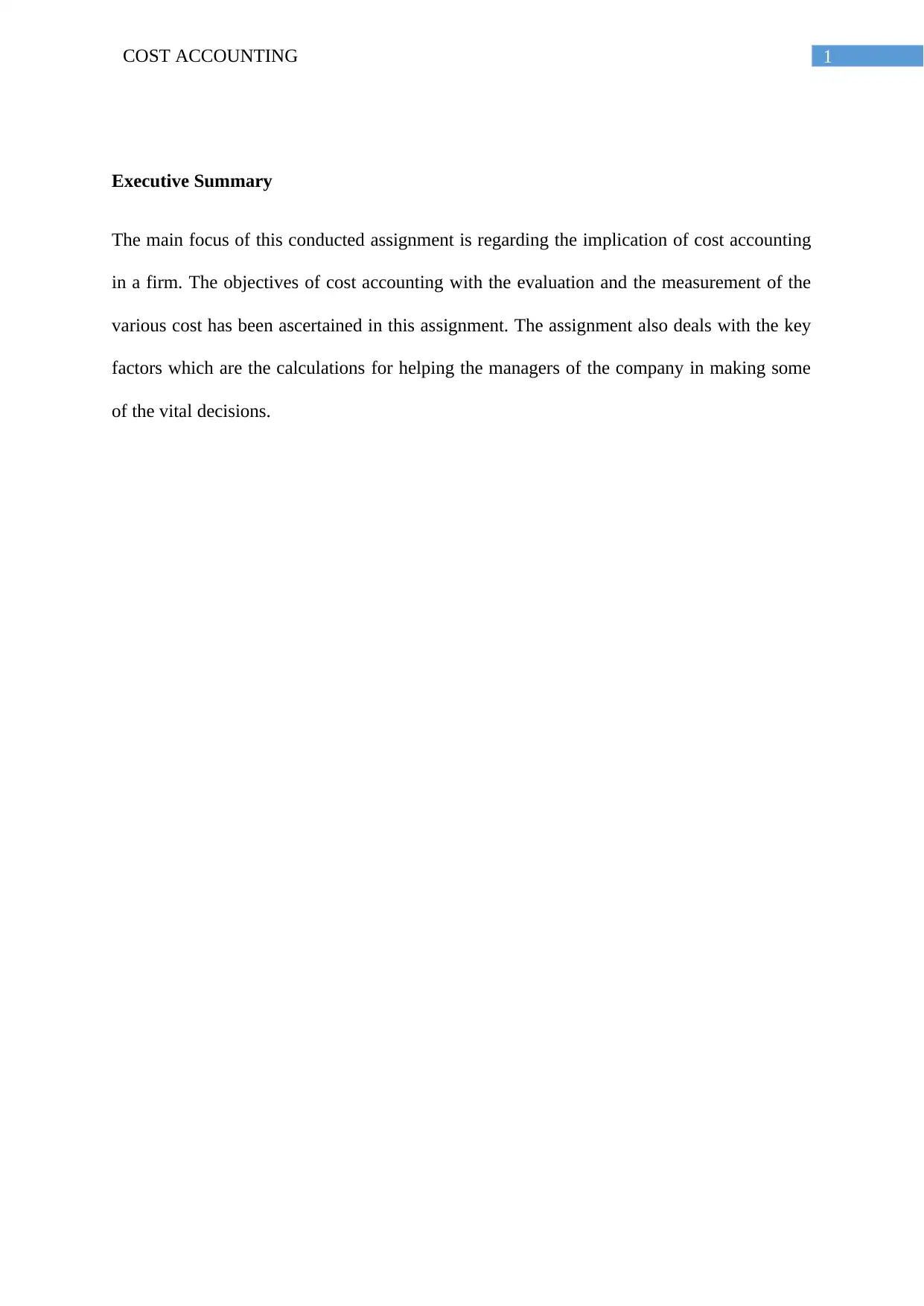
1COST ACCOUNTING
Executive Summary
The main focus of this conducted assignment is regarding the implication of cost accounting
in a firm. The objectives of cost accounting with the evaluation and the measurement of the
various cost has been ascertained in this assignment. The assignment also deals with the key
factors which are the calculations for helping the managers of the company in making some
of the vital decisions.
Executive Summary
The main focus of this conducted assignment is regarding the implication of cost accounting
in a firm. The objectives of cost accounting with the evaluation and the measurement of the
various cost has been ascertained in this assignment. The assignment also deals with the key
factors which are the calculations for helping the managers of the company in making some
of the vital decisions.
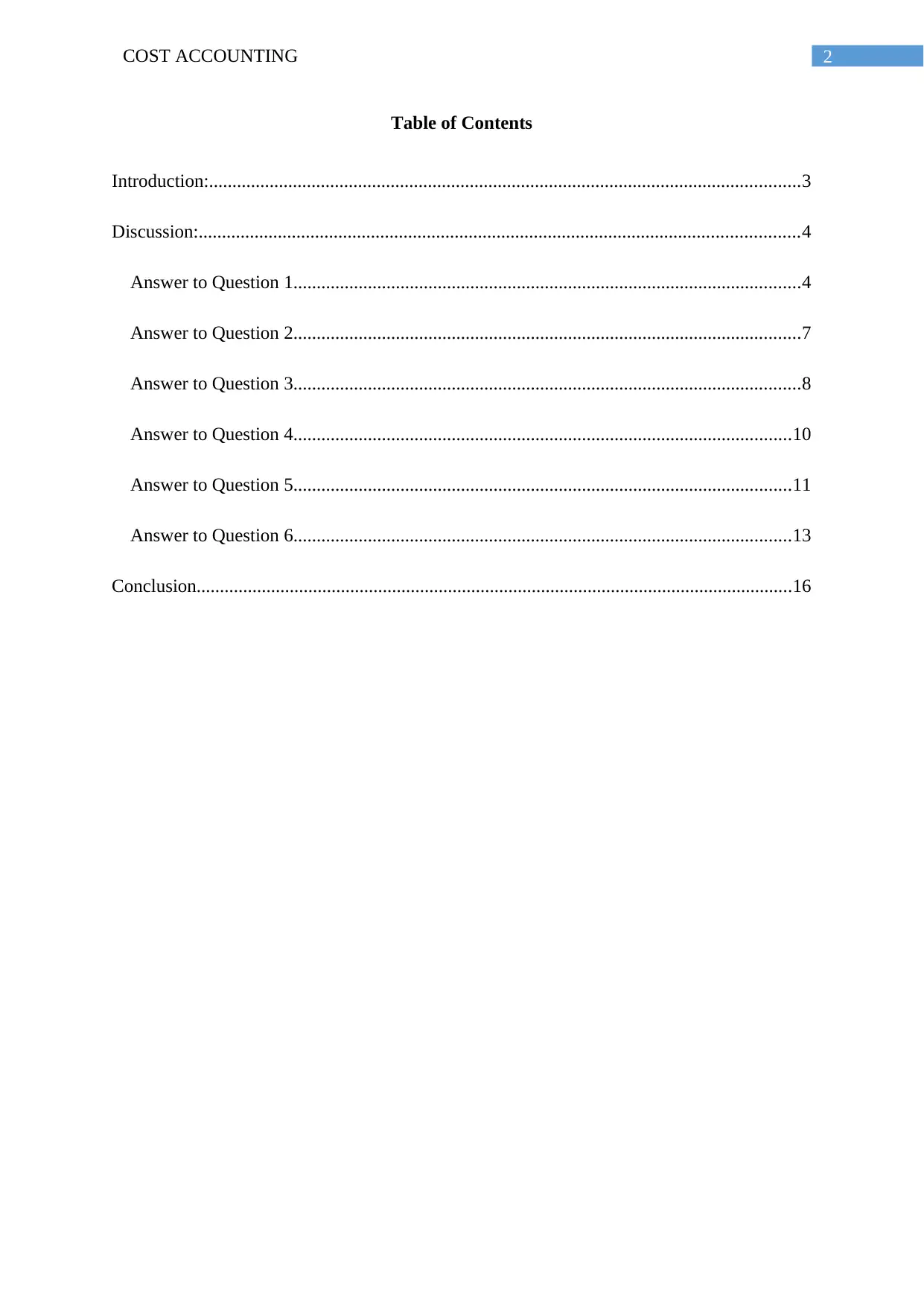
2COST ACCOUNTING
Table of Contents
Introduction:...............................................................................................................................3
Discussion:.................................................................................................................................4
Answer to Question 1.............................................................................................................4
Answer to Question 2.............................................................................................................7
Answer to Question 3.............................................................................................................8
Answer to Question 4...........................................................................................................10
Answer to Question 5...........................................................................................................11
Answer to Question 6...........................................................................................................13
Conclusion................................................................................................................................16
Table of Contents
Introduction:...............................................................................................................................3
Discussion:.................................................................................................................................4
Answer to Question 1.............................................................................................................4
Answer to Question 2.............................................................................................................7
Answer to Question 3.............................................................................................................8
Answer to Question 4...........................................................................................................10
Answer to Question 5...........................................................................................................11
Answer to Question 6...........................................................................................................13
Conclusion................................................................................................................................16
⊘ This is a preview!⊘
Do you want full access?
Subscribe today to unlock all pages.

Trusted by 1+ million students worldwide
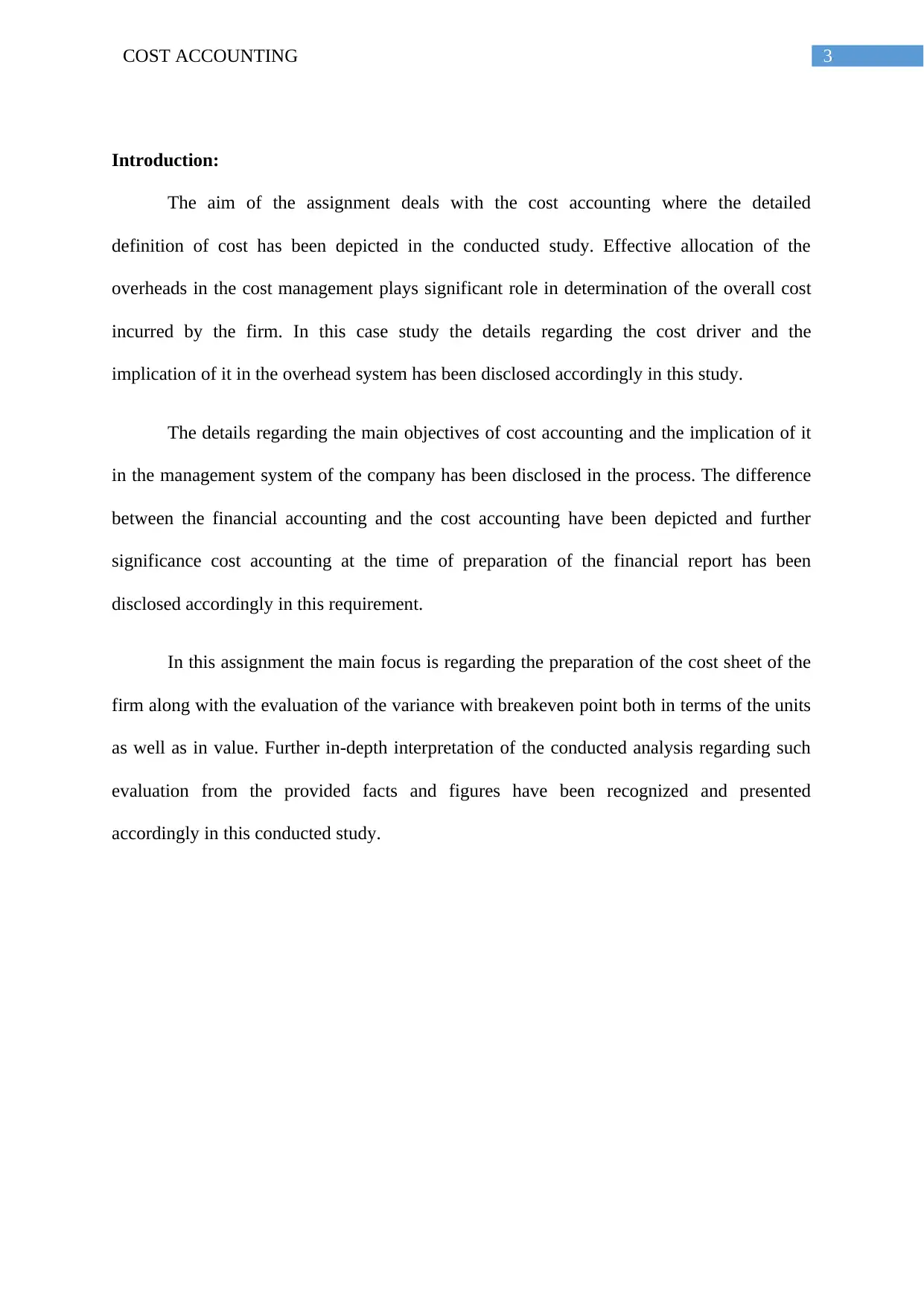
3COST ACCOUNTING
Introduction:
The aim of the assignment deals with the cost accounting where the detailed
definition of cost has been depicted in the conducted study. Effective allocation of the
overheads in the cost management plays significant role in determination of the overall cost
incurred by the firm. In this case study the details regarding the cost driver and the
implication of it in the overhead system has been disclosed accordingly in this study.
The details regarding the main objectives of cost accounting and the implication of it
in the management system of the company has been disclosed in the process. The difference
between the financial accounting and the cost accounting have been depicted and further
significance cost accounting at the time of preparation of the financial report has been
disclosed accordingly in this requirement.
In this assignment the main focus is regarding the preparation of the cost sheet of the
firm along with the evaluation of the variance with breakeven point both in terms of the units
as well as in value. Further in-depth interpretation of the conducted analysis regarding such
evaluation from the provided facts and figures have been recognized and presented
accordingly in this conducted study.
Introduction:
The aim of the assignment deals with the cost accounting where the detailed
definition of cost has been depicted in the conducted study. Effective allocation of the
overheads in the cost management plays significant role in determination of the overall cost
incurred by the firm. In this case study the details regarding the cost driver and the
implication of it in the overhead system has been disclosed accordingly in this study.
The details regarding the main objectives of cost accounting and the implication of it
in the management system of the company has been disclosed in the process. The difference
between the financial accounting and the cost accounting have been depicted and further
significance cost accounting at the time of preparation of the financial report has been
disclosed accordingly in this requirement.
In this assignment the main focus is regarding the preparation of the cost sheet of the
firm along with the evaluation of the variance with breakeven point both in terms of the units
as well as in value. Further in-depth interpretation of the conducted analysis regarding such
evaluation from the provided facts and figures have been recognized and presented
accordingly in this conducted study.
Paraphrase This Document
Need a fresh take? Get an instant paraphrase of this document with our AI Paraphraser
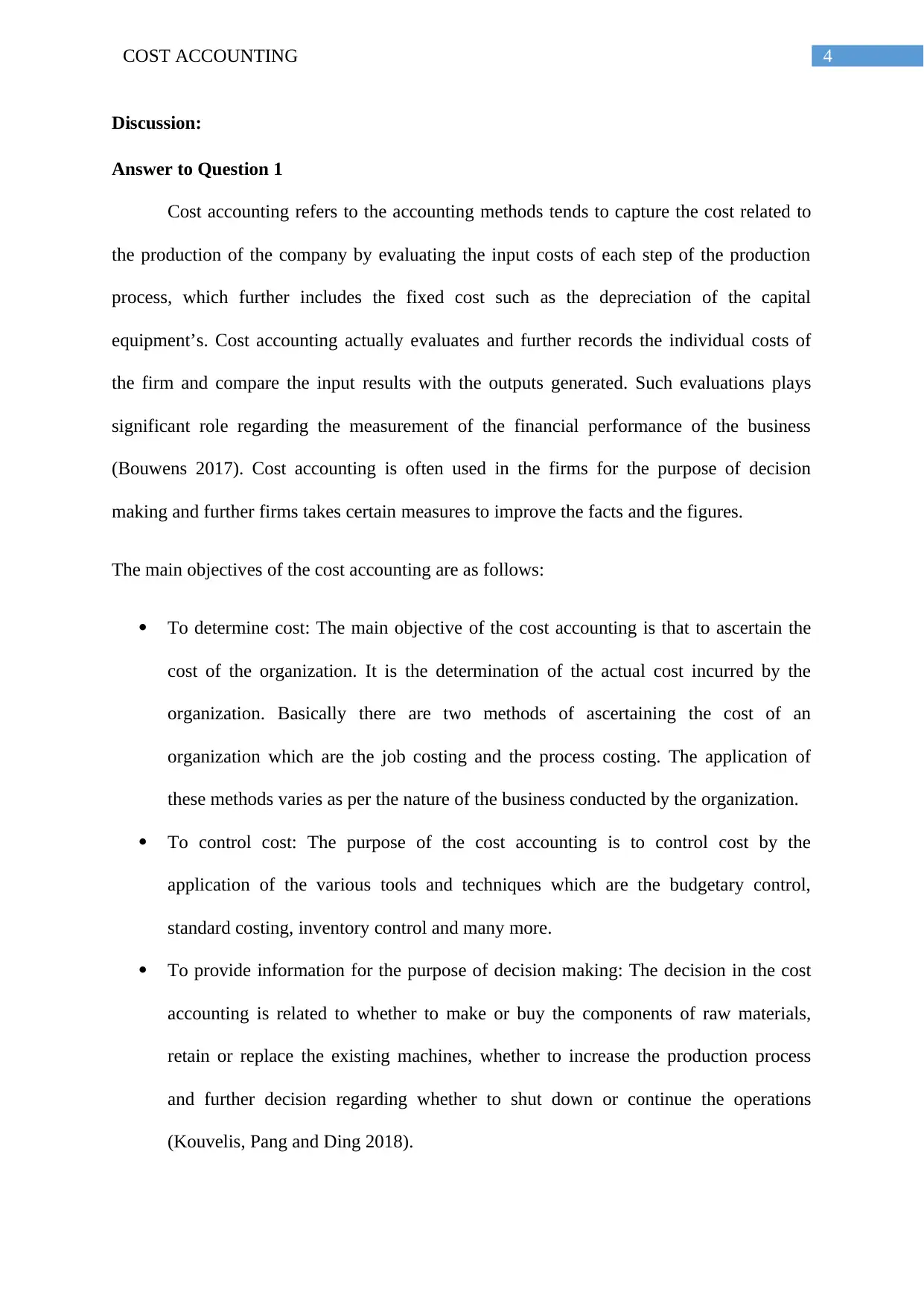
4COST ACCOUNTING
Discussion:
Answer to Question 1
Cost accounting refers to the accounting methods tends to capture the cost related to
the production of the company by evaluating the input costs of each step of the production
process, which further includes the fixed cost such as the depreciation of the capital
equipment’s. Cost accounting actually evaluates and further records the individual costs of
the firm and compare the input results with the outputs generated. Such evaluations plays
significant role regarding the measurement of the financial performance of the business
(Bouwens 2017). Cost accounting is often used in the firms for the purpose of decision
making and further firms takes certain measures to improve the facts and the figures.
The main objectives of the cost accounting are as follows:
To determine cost: The main objective of the cost accounting is that to ascertain the
cost of the organization. It is the determination of the actual cost incurred by the
organization. Basically there are two methods of ascertaining the cost of an
organization which are the job costing and the process costing. The application of
these methods varies as per the nature of the business conducted by the organization.
To control cost: The purpose of the cost accounting is to control cost by the
application of the various tools and techniques which are the budgetary control,
standard costing, inventory control and many more.
To provide information for the purpose of decision making: The decision in the cost
accounting is related to whether to make or buy the components of raw materials,
retain or replace the existing machines, whether to increase the production process
and further decision regarding whether to shut down or continue the operations
(Kouvelis, Pang and Ding 2018).
Discussion:
Answer to Question 1
Cost accounting refers to the accounting methods tends to capture the cost related to
the production of the company by evaluating the input costs of each step of the production
process, which further includes the fixed cost such as the depreciation of the capital
equipment’s. Cost accounting actually evaluates and further records the individual costs of
the firm and compare the input results with the outputs generated. Such evaluations plays
significant role regarding the measurement of the financial performance of the business
(Bouwens 2017). Cost accounting is often used in the firms for the purpose of decision
making and further firms takes certain measures to improve the facts and the figures.
The main objectives of the cost accounting are as follows:
To determine cost: The main objective of the cost accounting is that to ascertain the
cost of the organization. It is the determination of the actual cost incurred by the
organization. Basically there are two methods of ascertaining the cost of an
organization which are the job costing and the process costing. The application of
these methods varies as per the nature of the business conducted by the organization.
To control cost: The purpose of the cost accounting is to control cost by the
application of the various tools and techniques which are the budgetary control,
standard costing, inventory control and many more.
To provide information for the purpose of decision making: The decision in the cost
accounting is related to whether to make or buy the components of raw materials,
retain or replace the existing machines, whether to increase the production process
and further decision regarding whether to shut down or continue the operations
(Kouvelis, Pang and Ding 2018).
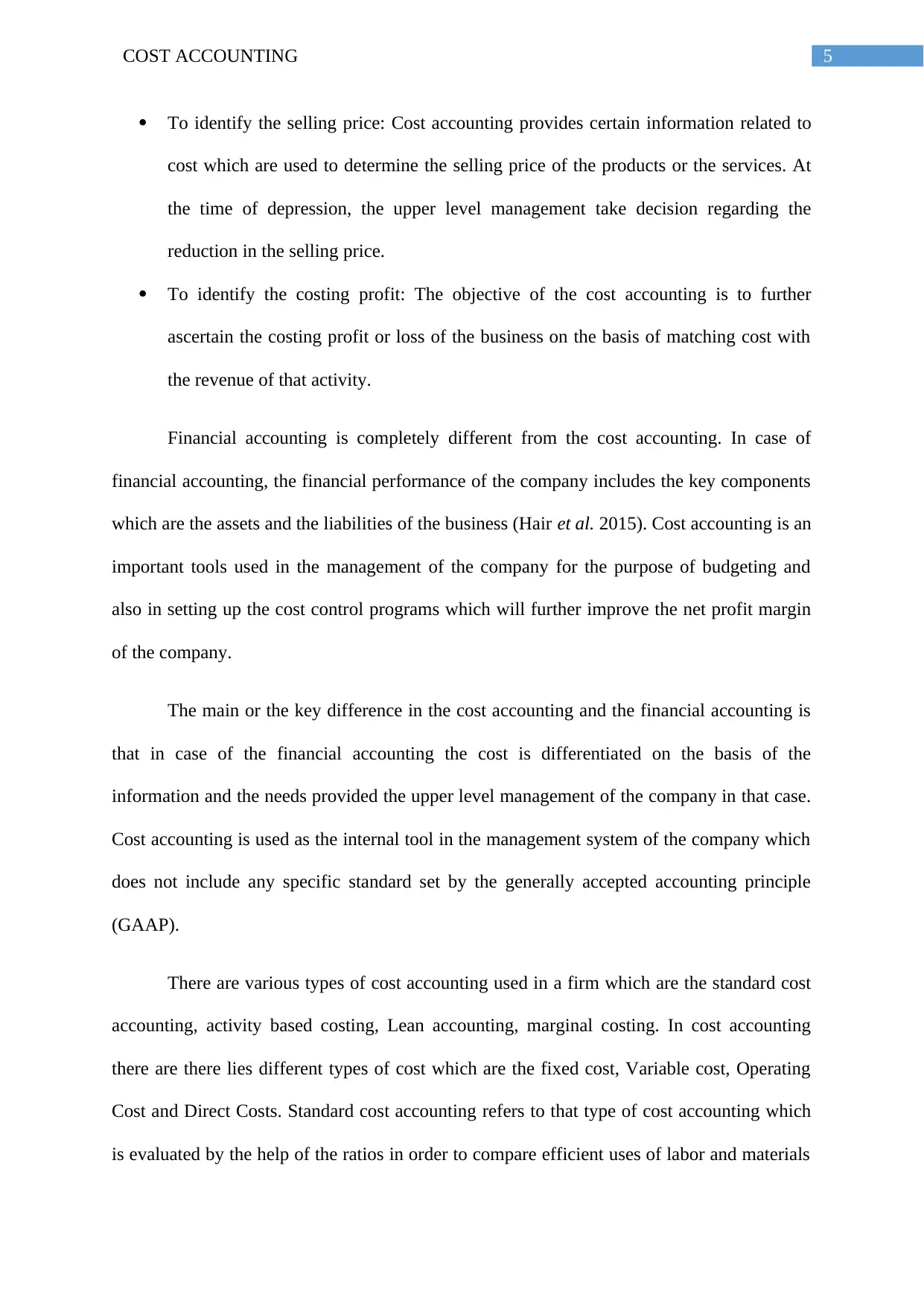
5COST ACCOUNTING
To identify the selling price: Cost accounting provides certain information related to
cost which are used to determine the selling price of the products or the services. At
the time of depression, the upper level management take decision regarding the
reduction in the selling price.
To identify the costing profit: The objective of the cost accounting is to further
ascertain the costing profit or loss of the business on the basis of matching cost with
the revenue of that activity.
Financial accounting is completely different from the cost accounting. In case of
financial accounting, the financial performance of the company includes the key components
which are the assets and the liabilities of the business (Hair et al. 2015). Cost accounting is an
important tools used in the management of the company for the purpose of budgeting and
also in setting up the cost control programs which will further improve the net profit margin
of the company.
The main or the key difference in the cost accounting and the financial accounting is
that in case of the financial accounting the cost is differentiated on the basis of the
information and the needs provided the upper level management of the company in that case.
Cost accounting is used as the internal tool in the management system of the company which
does not include any specific standard set by the generally accepted accounting principle
(GAAP).
There are various types of cost accounting used in a firm which are the standard cost
accounting, activity based costing, Lean accounting, marginal costing. In cost accounting
there are there lies different types of cost which are the fixed cost, Variable cost, Operating
Cost and Direct Costs. Standard cost accounting refers to that type of cost accounting which
is evaluated by the help of the ratios in order to compare efficient uses of labor and materials
To identify the selling price: Cost accounting provides certain information related to
cost which are used to determine the selling price of the products or the services. At
the time of depression, the upper level management take decision regarding the
reduction in the selling price.
To identify the costing profit: The objective of the cost accounting is to further
ascertain the costing profit or loss of the business on the basis of matching cost with
the revenue of that activity.
Financial accounting is completely different from the cost accounting. In case of
financial accounting, the financial performance of the company includes the key components
which are the assets and the liabilities of the business (Hair et al. 2015). Cost accounting is an
important tools used in the management of the company for the purpose of budgeting and
also in setting up the cost control programs which will further improve the net profit margin
of the company.
The main or the key difference in the cost accounting and the financial accounting is
that in case of the financial accounting the cost is differentiated on the basis of the
information and the needs provided the upper level management of the company in that case.
Cost accounting is used as the internal tool in the management system of the company which
does not include any specific standard set by the generally accepted accounting principle
(GAAP).
There are various types of cost accounting used in a firm which are the standard cost
accounting, activity based costing, Lean accounting, marginal costing. In cost accounting
there are there lies different types of cost which are the fixed cost, Variable cost, Operating
Cost and Direct Costs. Standard cost accounting refers to that type of cost accounting which
is evaluated by the help of the ratios in order to compare efficient uses of labor and materials
⊘ This is a preview!⊘
Do you want full access?
Subscribe today to unlock all pages.

Trusted by 1+ million students worldwide
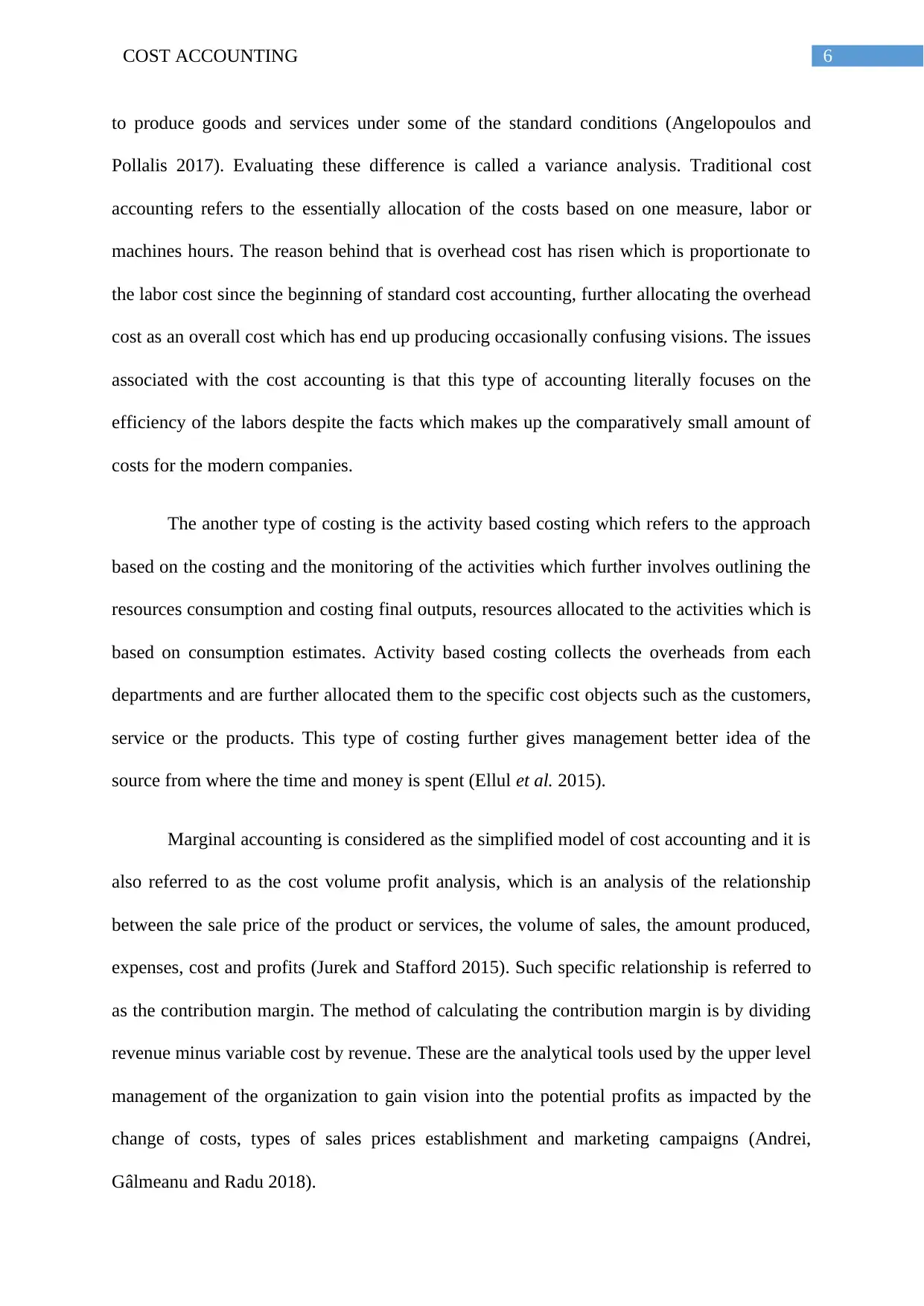
6COST ACCOUNTING
to produce goods and services under some of the standard conditions (Angelopoulos and
Pollalis 2017). Evaluating these difference is called a variance analysis. Traditional cost
accounting refers to the essentially allocation of the costs based on one measure, labor or
machines hours. The reason behind that is overhead cost has risen which is proportionate to
the labor cost since the beginning of standard cost accounting, further allocating the overhead
cost as an overall cost which has end up producing occasionally confusing visions. The issues
associated with the cost accounting is that this type of accounting literally focuses on the
efficiency of the labors despite the facts which makes up the comparatively small amount of
costs for the modern companies.
The another type of costing is the activity based costing which refers to the approach
based on the costing and the monitoring of the activities which further involves outlining the
resources consumption and costing final outputs, resources allocated to the activities which is
based on consumption estimates. Activity based costing collects the overheads from each
departments and are further allocated them to the specific cost objects such as the customers,
service or the products. This type of costing further gives management better idea of the
source from where the time and money is spent (Ellul et al. 2015).
Marginal accounting is considered as the simplified model of cost accounting and it is
also referred to as the cost volume profit analysis, which is an analysis of the relationship
between the sale price of the product or services, the volume of sales, the amount produced,
expenses, cost and profits (Jurek and Stafford 2015). Such specific relationship is referred to
as the contribution margin. The method of calculating the contribution margin is by dividing
revenue minus variable cost by revenue. These are the analytical tools used by the upper level
management of the organization to gain vision into the potential profits as impacted by the
change of costs, types of sales prices establishment and marketing campaigns (Andrei,
Gâlmeanu and Radu 2018).
to produce goods and services under some of the standard conditions (Angelopoulos and
Pollalis 2017). Evaluating these difference is called a variance analysis. Traditional cost
accounting refers to the essentially allocation of the costs based on one measure, labor or
machines hours. The reason behind that is overhead cost has risen which is proportionate to
the labor cost since the beginning of standard cost accounting, further allocating the overhead
cost as an overall cost which has end up producing occasionally confusing visions. The issues
associated with the cost accounting is that this type of accounting literally focuses on the
efficiency of the labors despite the facts which makes up the comparatively small amount of
costs for the modern companies.
The another type of costing is the activity based costing which refers to the approach
based on the costing and the monitoring of the activities which further involves outlining the
resources consumption and costing final outputs, resources allocated to the activities which is
based on consumption estimates. Activity based costing collects the overheads from each
departments and are further allocated them to the specific cost objects such as the customers,
service or the products. This type of costing further gives management better idea of the
source from where the time and money is spent (Ellul et al. 2015).
Marginal accounting is considered as the simplified model of cost accounting and it is
also referred to as the cost volume profit analysis, which is an analysis of the relationship
between the sale price of the product or services, the volume of sales, the amount produced,
expenses, cost and profits (Jurek and Stafford 2015). Such specific relationship is referred to
as the contribution margin. The method of calculating the contribution margin is by dividing
revenue minus variable cost by revenue. These are the analytical tools used by the upper level
management of the organization to gain vision into the potential profits as impacted by the
change of costs, types of sales prices establishment and marketing campaigns (Andrei,
Gâlmeanu and Radu 2018).
Paraphrase This Document
Need a fresh take? Get an instant paraphrase of this document with our AI Paraphraser
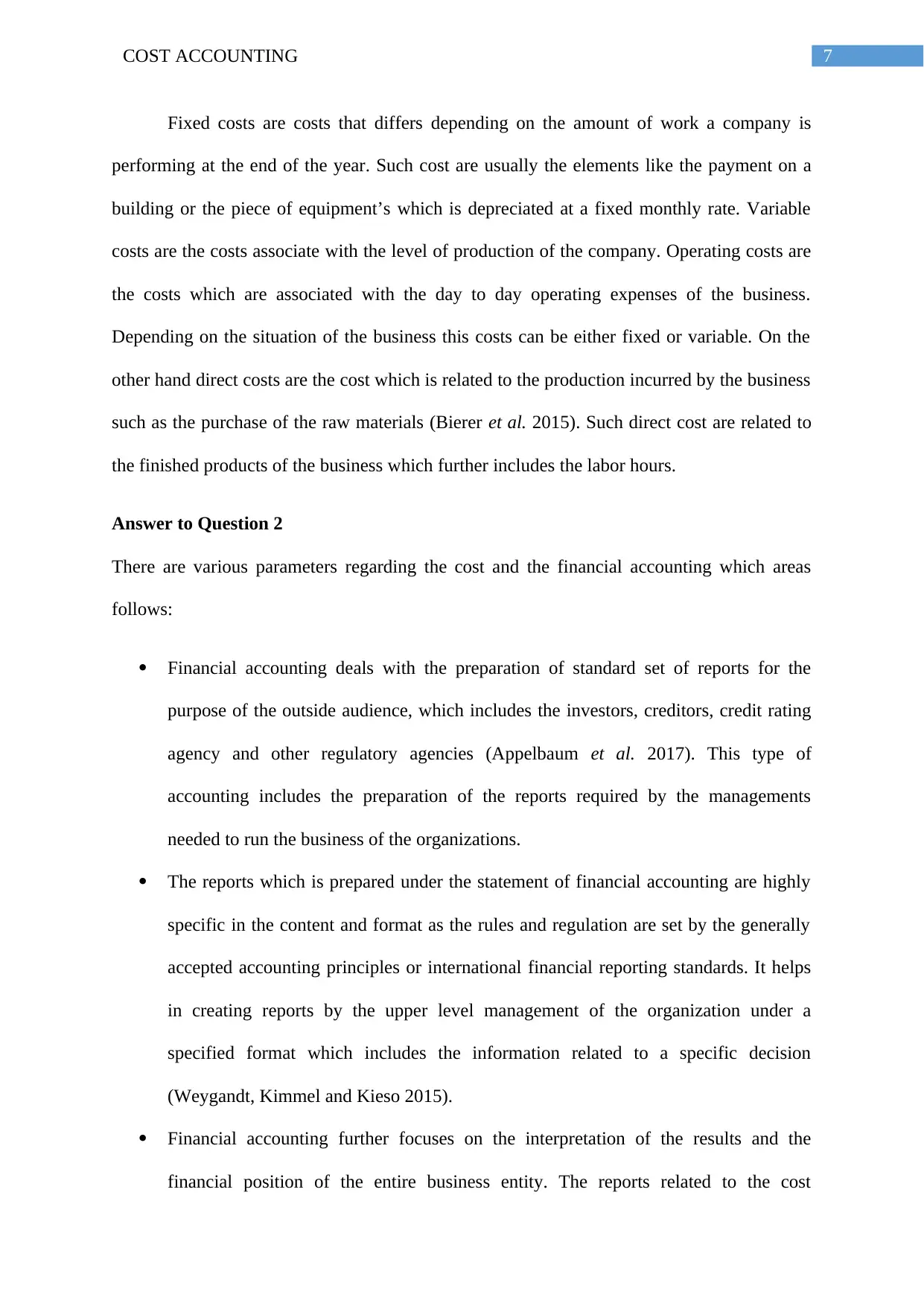
7COST ACCOUNTING
Fixed costs are costs that differs depending on the amount of work a company is
performing at the end of the year. Such cost are usually the elements like the payment on a
building or the piece of equipment’s which is depreciated at a fixed monthly rate. Variable
costs are the costs associate with the level of production of the company. Operating costs are
the costs which are associated with the day to day operating expenses of the business.
Depending on the situation of the business this costs can be either fixed or variable. On the
other hand direct costs are the cost which is related to the production incurred by the business
such as the purchase of the raw materials (Bierer et al. 2015). Such direct cost are related to
the finished products of the business which further includes the labor hours.
Answer to Question 2
There are various parameters regarding the cost and the financial accounting which areas
follows:
Financial accounting deals with the preparation of standard set of reports for the
purpose of the outside audience, which includes the investors, creditors, credit rating
agency and other regulatory agencies (Appelbaum et al. 2017). This type of
accounting includes the preparation of the reports required by the managements
needed to run the business of the organizations.
The reports which is prepared under the statement of financial accounting are highly
specific in the content and format as the rules and regulation are set by the generally
accepted accounting principles or international financial reporting standards. It helps
in creating reports by the upper level management of the organization under a
specified format which includes the information related to a specific decision
(Weygandt, Kimmel and Kieso 2015).
Financial accounting further focuses on the interpretation of the results and the
financial position of the entire business entity. The reports related to the cost
Fixed costs are costs that differs depending on the amount of work a company is
performing at the end of the year. Such cost are usually the elements like the payment on a
building or the piece of equipment’s which is depreciated at a fixed monthly rate. Variable
costs are the costs associate with the level of production of the company. Operating costs are
the costs which are associated with the day to day operating expenses of the business.
Depending on the situation of the business this costs can be either fixed or variable. On the
other hand direct costs are the cost which is related to the production incurred by the business
such as the purchase of the raw materials (Bierer et al. 2015). Such direct cost are related to
the finished products of the business which further includes the labor hours.
Answer to Question 2
There are various parameters regarding the cost and the financial accounting which areas
follows:
Financial accounting deals with the preparation of standard set of reports for the
purpose of the outside audience, which includes the investors, creditors, credit rating
agency and other regulatory agencies (Appelbaum et al. 2017). This type of
accounting includes the preparation of the reports required by the managements
needed to run the business of the organizations.
The reports which is prepared under the statement of financial accounting are highly
specific in the content and format as the rules and regulation are set by the generally
accepted accounting principles or international financial reporting standards. It helps
in creating reports by the upper level management of the organization under a
specified format which includes the information related to a specific decision
(Weygandt, Kimmel and Kieso 2015).
Financial accounting further focuses on the interpretation of the results and the
financial position of the entire business entity. The reports related to the cost
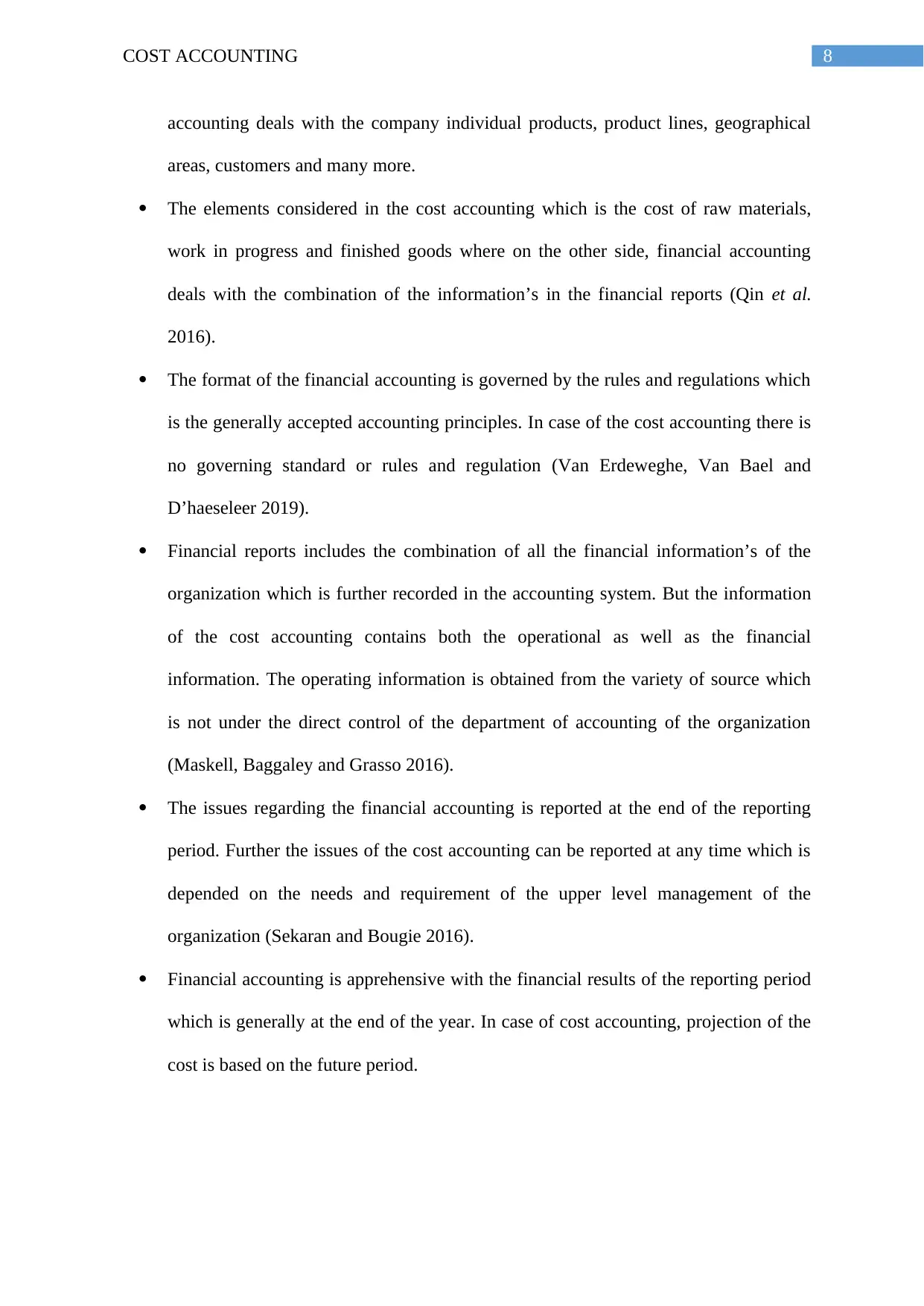
8COST ACCOUNTING
accounting deals with the company individual products, product lines, geographical
areas, customers and many more.
The elements considered in the cost accounting which is the cost of raw materials,
work in progress and finished goods where on the other side, financial accounting
deals with the combination of the information’s in the financial reports (Qin et al.
2016).
The format of the financial accounting is governed by the rules and regulations which
is the generally accepted accounting principles. In case of the cost accounting there is
no governing standard or rules and regulation (Van Erdeweghe, Van Bael and
D’haeseleer 2019).
Financial reports includes the combination of all the financial information’s of the
organization which is further recorded in the accounting system. But the information
of the cost accounting contains both the operational as well as the financial
information. The operating information is obtained from the variety of source which
is not under the direct control of the department of accounting of the organization
(Maskell, Baggaley and Grasso 2016).
The issues regarding the financial accounting is reported at the end of the reporting
period. Further the issues of the cost accounting can be reported at any time which is
depended on the needs and requirement of the upper level management of the
organization (Sekaran and Bougie 2016).
Financial accounting is apprehensive with the financial results of the reporting period
which is generally at the end of the year. In case of cost accounting, projection of the
cost is based on the future period.
accounting deals with the company individual products, product lines, geographical
areas, customers and many more.
The elements considered in the cost accounting which is the cost of raw materials,
work in progress and finished goods where on the other side, financial accounting
deals with the combination of the information’s in the financial reports (Qin et al.
2016).
The format of the financial accounting is governed by the rules and regulations which
is the generally accepted accounting principles. In case of the cost accounting there is
no governing standard or rules and regulation (Van Erdeweghe, Van Bael and
D’haeseleer 2019).
Financial reports includes the combination of all the financial information’s of the
organization which is further recorded in the accounting system. But the information
of the cost accounting contains both the operational as well as the financial
information. The operating information is obtained from the variety of source which
is not under the direct control of the department of accounting of the organization
(Maskell, Baggaley and Grasso 2016).
The issues regarding the financial accounting is reported at the end of the reporting
period. Further the issues of the cost accounting can be reported at any time which is
depended on the needs and requirement of the upper level management of the
organization (Sekaran and Bougie 2016).
Financial accounting is apprehensive with the financial results of the reporting period
which is generally at the end of the year. In case of cost accounting, projection of the
cost is based on the future period.
⊘ This is a preview!⊘
Do you want full access?
Subscribe today to unlock all pages.

Trusted by 1+ million students worldwide
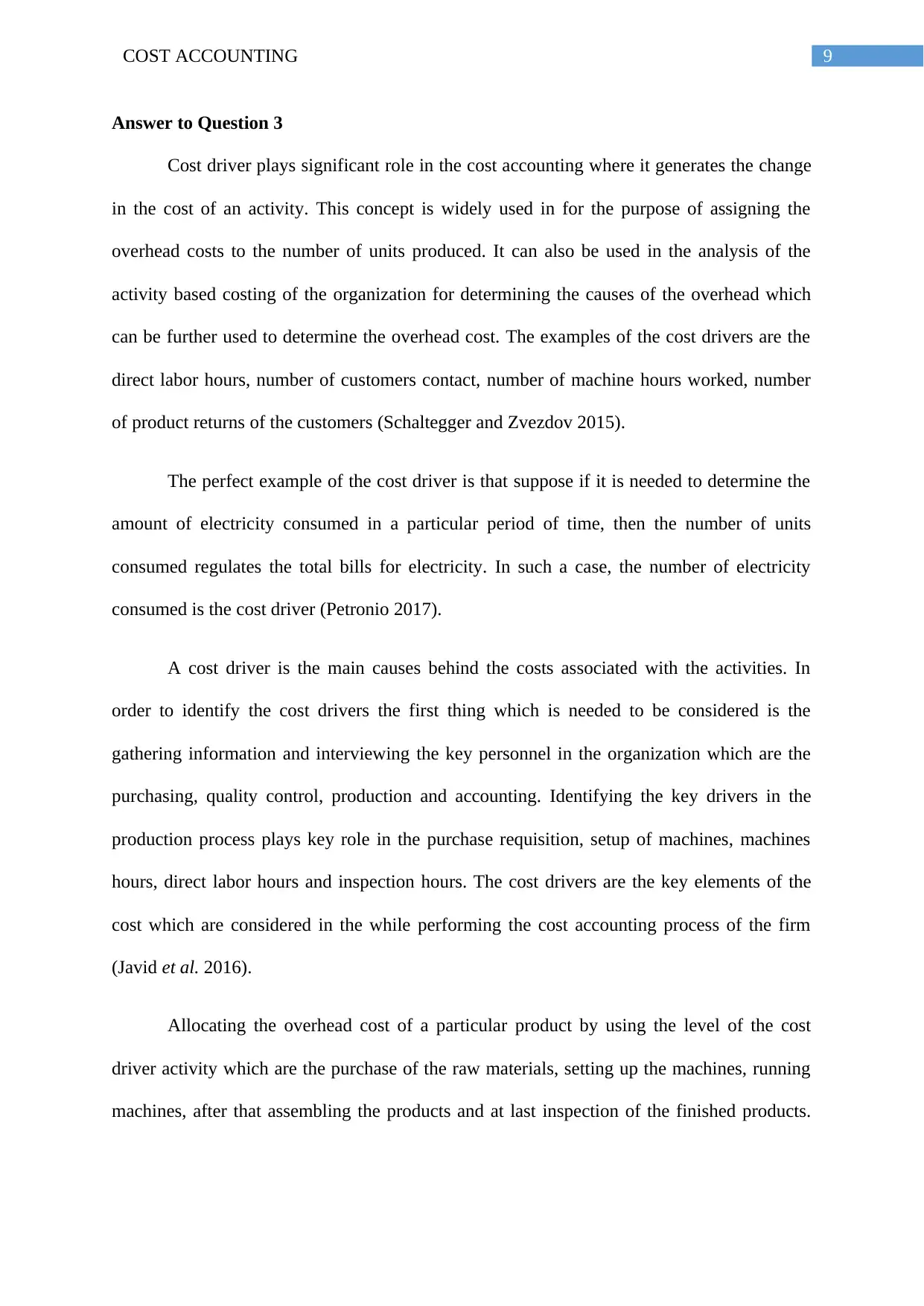
9COST ACCOUNTING
Answer to Question 3
Cost driver plays significant role in the cost accounting where it generates the change
in the cost of an activity. This concept is widely used in for the purpose of assigning the
overhead costs to the number of units produced. It can also be used in the analysis of the
activity based costing of the organization for determining the causes of the overhead which
can be further used to determine the overhead cost. The examples of the cost drivers are the
direct labor hours, number of customers contact, number of machine hours worked, number
of product returns of the customers (Schaltegger and Zvezdov 2015).
The perfect example of the cost driver is that suppose if it is needed to determine the
amount of electricity consumed in a particular period of time, then the number of units
consumed regulates the total bills for electricity. In such a case, the number of electricity
consumed is the cost driver (Petronio 2017).
A cost driver is the main causes behind the costs associated with the activities. In
order to identify the cost drivers the first thing which is needed to be considered is the
gathering information and interviewing the key personnel in the organization which are the
purchasing, quality control, production and accounting. Identifying the key drivers in the
production process plays key role in the purchase requisition, setup of machines, machines
hours, direct labor hours and inspection hours. The cost drivers are the key elements of the
cost which are considered in the while performing the cost accounting process of the firm
(Javid et al. 2016).
Allocating the overhead cost of a particular product by using the level of the cost
driver activity which are the purchase of the raw materials, setting up the machines, running
machines, after that assembling the products and at last inspection of the finished products.
Answer to Question 3
Cost driver plays significant role in the cost accounting where it generates the change
in the cost of an activity. This concept is widely used in for the purpose of assigning the
overhead costs to the number of units produced. It can also be used in the analysis of the
activity based costing of the organization for determining the causes of the overhead which
can be further used to determine the overhead cost. The examples of the cost drivers are the
direct labor hours, number of customers contact, number of machine hours worked, number
of product returns of the customers (Schaltegger and Zvezdov 2015).
The perfect example of the cost driver is that suppose if it is needed to determine the
amount of electricity consumed in a particular period of time, then the number of units
consumed regulates the total bills for electricity. In such a case, the number of electricity
consumed is the cost driver (Petronio 2017).
A cost driver is the main causes behind the costs associated with the activities. In
order to identify the cost drivers the first thing which is needed to be considered is the
gathering information and interviewing the key personnel in the organization which are the
purchasing, quality control, production and accounting. Identifying the key drivers in the
production process plays key role in the purchase requisition, setup of machines, machines
hours, direct labor hours and inspection hours. The cost drivers are the key elements of the
cost which are considered in the while performing the cost accounting process of the firm
(Javid et al. 2016).
Allocating the overhead cost of a particular product by using the level of the cost
driver activity which are the purchase of the raw materials, setting up the machines, running
machines, after that assembling the products and at last inspection of the finished products.
Paraphrase This Document
Need a fresh take? Get an instant paraphrase of this document with our AI Paraphraser
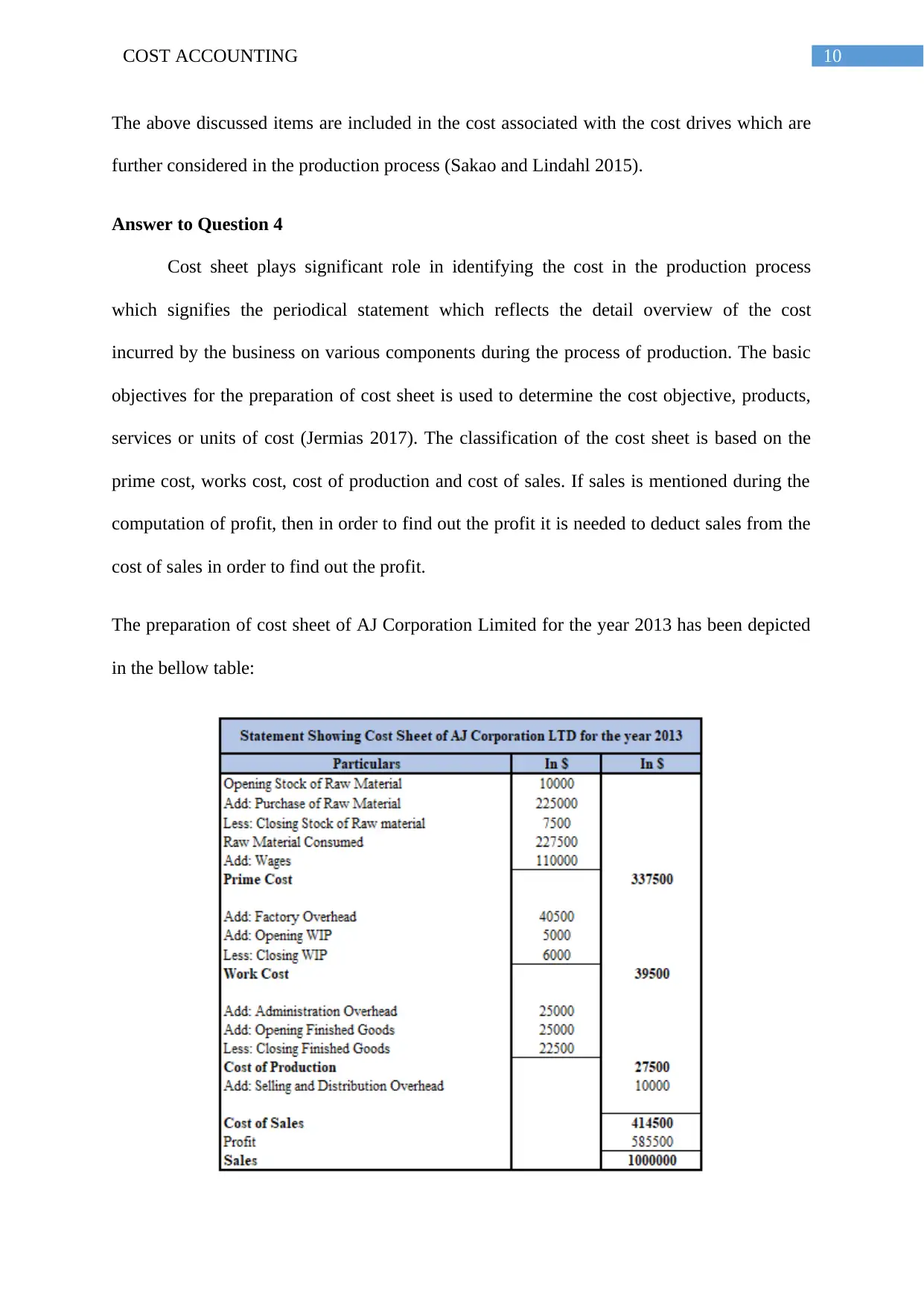
10COST ACCOUNTING
The above discussed items are included in the cost associated with the cost drives which are
further considered in the production process (Sakao and Lindahl 2015).
Answer to Question 4
Cost sheet plays significant role in identifying the cost in the production process
which signifies the periodical statement which reflects the detail overview of the cost
incurred by the business on various components during the process of production. The basic
objectives for the preparation of cost sheet is used to determine the cost objective, products,
services or units of cost (Jermias 2017). The classification of the cost sheet is based on the
prime cost, works cost, cost of production and cost of sales. If sales is mentioned during the
computation of profit, then in order to find out the profit it is needed to deduct sales from the
cost of sales in order to find out the profit.
The preparation of cost sheet of AJ Corporation Limited for the year 2013 has been depicted
in the bellow table:
The above discussed items are included in the cost associated with the cost drives which are
further considered in the production process (Sakao and Lindahl 2015).
Answer to Question 4
Cost sheet plays significant role in identifying the cost in the production process
which signifies the periodical statement which reflects the detail overview of the cost
incurred by the business on various components during the process of production. The basic
objectives for the preparation of cost sheet is used to determine the cost objective, products,
services or units of cost (Jermias 2017). The classification of the cost sheet is based on the
prime cost, works cost, cost of production and cost of sales. If sales is mentioned during the
computation of profit, then in order to find out the profit it is needed to deduct sales from the
cost of sales in order to find out the profit.
The preparation of cost sheet of AJ Corporation Limited for the year 2013 has been depicted
in the bellow table:
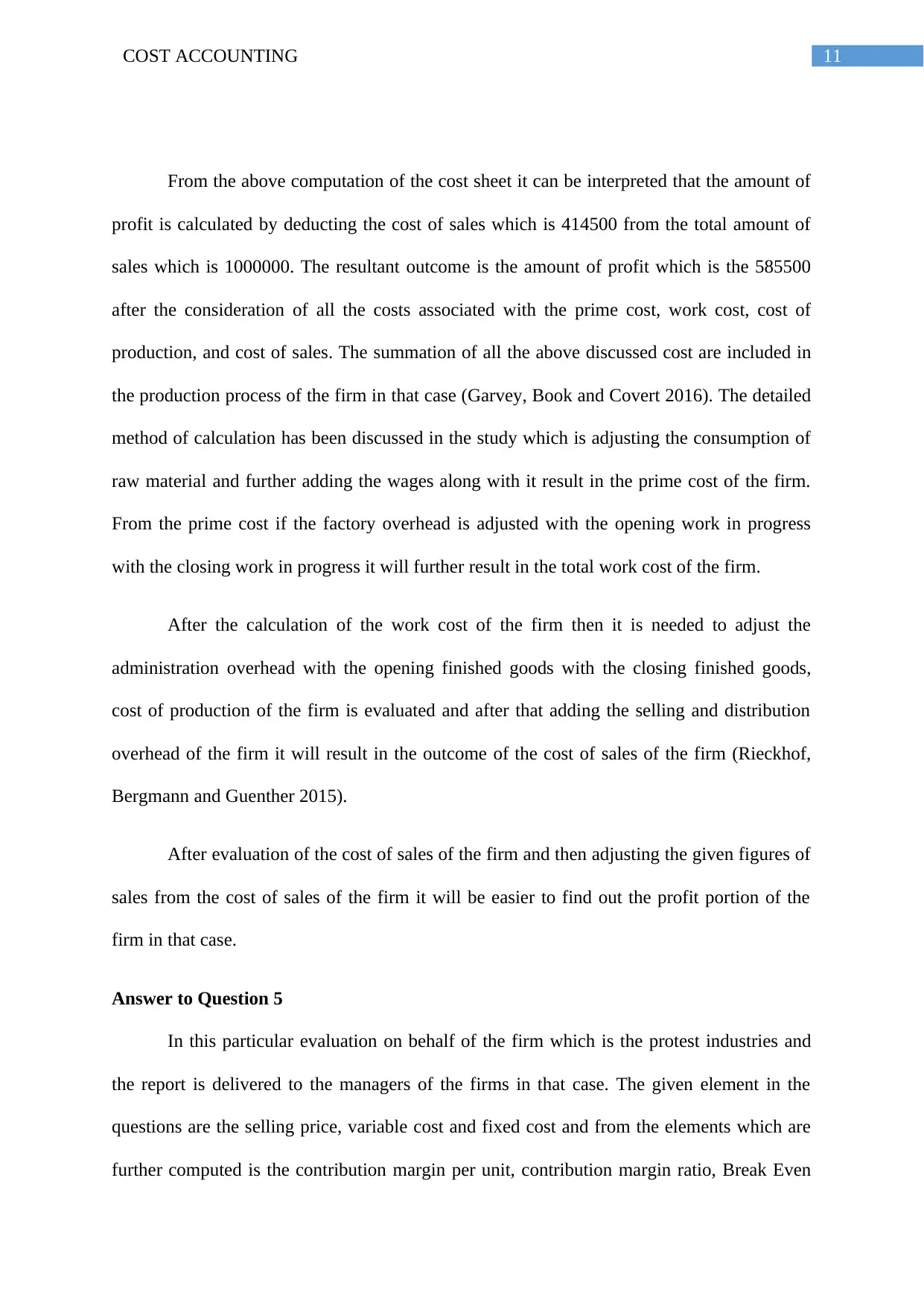
11COST ACCOUNTING
From the above computation of the cost sheet it can be interpreted that the amount of
profit is calculated by deducting the cost of sales which is 414500 from the total amount of
sales which is 1000000. The resultant outcome is the amount of profit which is the 585500
after the consideration of all the costs associated with the prime cost, work cost, cost of
production, and cost of sales. The summation of all the above discussed cost are included in
the production process of the firm in that case (Garvey, Book and Covert 2016). The detailed
method of calculation has been discussed in the study which is adjusting the consumption of
raw material and further adding the wages along with it result in the prime cost of the firm.
From the prime cost if the factory overhead is adjusted with the opening work in progress
with the closing work in progress it will further result in the total work cost of the firm.
After the calculation of the work cost of the firm then it is needed to adjust the
administration overhead with the opening finished goods with the closing finished goods,
cost of production of the firm is evaluated and after that adding the selling and distribution
overhead of the firm it will result in the outcome of the cost of sales of the firm (Rieckhof,
Bergmann and Guenther 2015).
After evaluation of the cost of sales of the firm and then adjusting the given figures of
sales from the cost of sales of the firm it will be easier to find out the profit portion of the
firm in that case.
Answer to Question 5
In this particular evaluation on behalf of the firm which is the protest industries and
the report is delivered to the managers of the firms in that case. The given element in the
questions are the selling price, variable cost and fixed cost and from the elements which are
further computed is the contribution margin per unit, contribution margin ratio, Break Even
From the above computation of the cost sheet it can be interpreted that the amount of
profit is calculated by deducting the cost of sales which is 414500 from the total amount of
sales which is 1000000. The resultant outcome is the amount of profit which is the 585500
after the consideration of all the costs associated with the prime cost, work cost, cost of
production, and cost of sales. The summation of all the above discussed cost are included in
the production process of the firm in that case (Garvey, Book and Covert 2016). The detailed
method of calculation has been discussed in the study which is adjusting the consumption of
raw material and further adding the wages along with it result in the prime cost of the firm.
From the prime cost if the factory overhead is adjusted with the opening work in progress
with the closing work in progress it will further result in the total work cost of the firm.
After the calculation of the work cost of the firm then it is needed to adjust the
administration overhead with the opening finished goods with the closing finished goods,
cost of production of the firm is evaluated and after that adding the selling and distribution
overhead of the firm it will result in the outcome of the cost of sales of the firm (Rieckhof,
Bergmann and Guenther 2015).
After evaluation of the cost of sales of the firm and then adjusting the given figures of
sales from the cost of sales of the firm it will be easier to find out the profit portion of the
firm in that case.
Answer to Question 5
In this particular evaluation on behalf of the firm which is the protest industries and
the report is delivered to the managers of the firms in that case. The given element in the
questions are the selling price, variable cost and fixed cost and from the elements which are
further computed is the contribution margin per unit, contribution margin ratio, Break Even
⊘ This is a preview!⊘
Do you want full access?
Subscribe today to unlock all pages.

Trusted by 1+ million students worldwide
1 out of 20
Related Documents
Your All-in-One AI-Powered Toolkit for Academic Success.
+13062052269
info@desklib.com
Available 24*7 on WhatsApp / Email
![[object Object]](/_next/static/media/star-bottom.7253800d.svg)
Unlock your academic potential
Copyright © 2020–2025 A2Z Services. All Rights Reserved. Developed and managed by ZUCOL.





